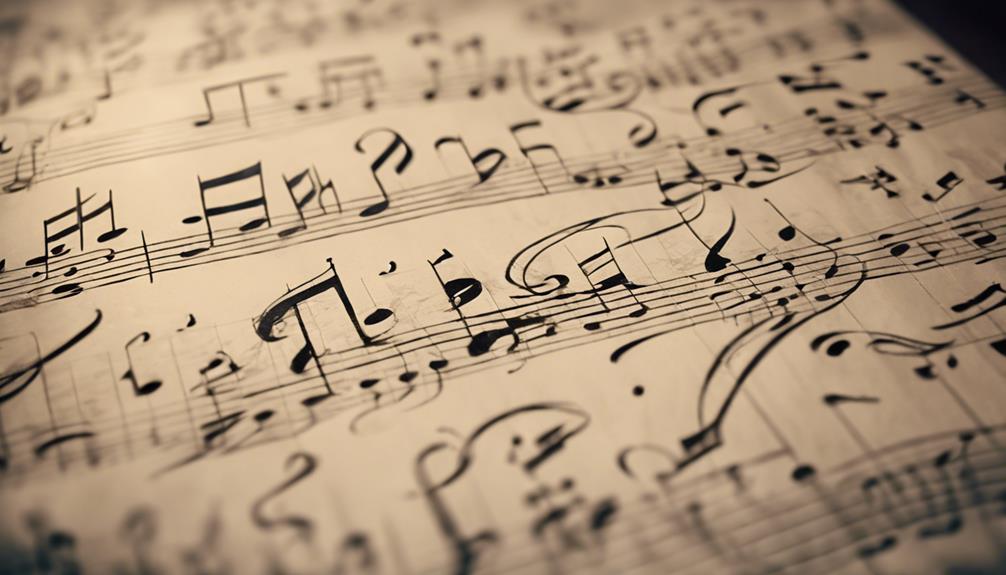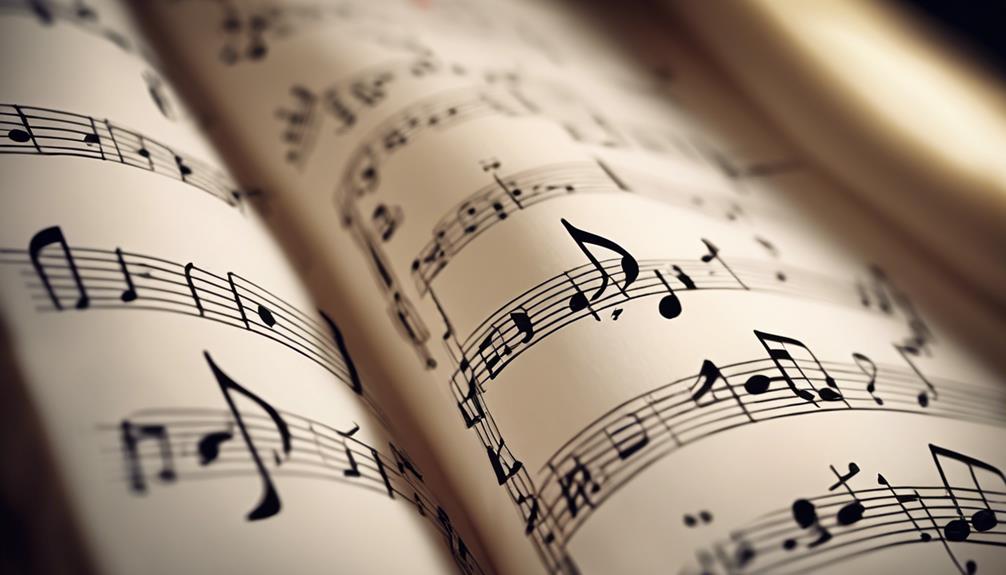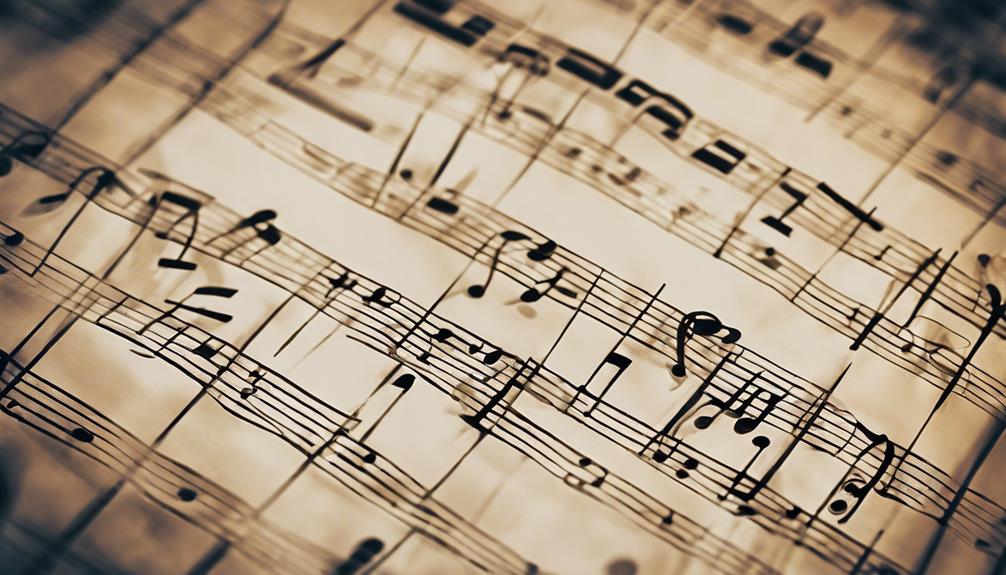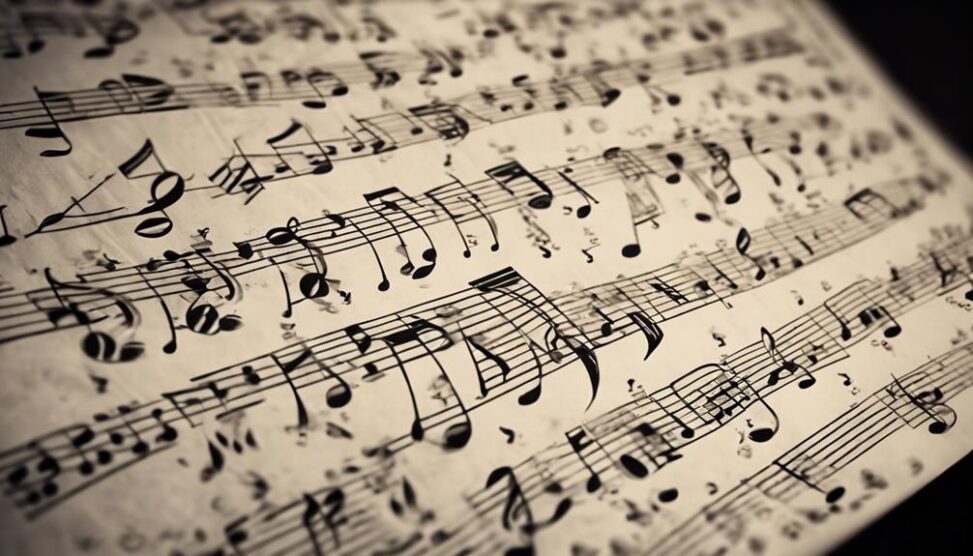Ever wondered how the evolution of music notation mirrors the changes in musical styles over the centuries?
From the intricate ornamentation of Baroque scores to the bold innovations of 20th-century avant-garde compositions, each era's sheet music tells a unique story.
As you trace the development from Baroque to Modern, you'll uncover fascinating insights into composers' creative processes and the societal influences that shaped their musical expressions.
Explore the hidden gems within the sheets, and you'll discover a rich tapestry of musical history waiting to be unraveled.
🌊 Discover Endless Fun with Beachcomber Press Puzzle Books! 🌊
Elevate your puzzle game with our captivating collection on Amazon.
Perfect for all ages, our books are packed with unique
challenges that promise hours of entertainment.
Key Takeaways
- Notational styles evolved from Baroque intricacy to minimalist contemporary approaches.
- Minimalist notation simplifies music, enhances clarity, and promotes deeper connections.
- Impact on musical structure: unconventional symbols, emphasis on rhythm, and fostering artistic exploration.
- Innovative notation encourages artistic freedom, collaboration, and dynamic musical experiences.
Baroque Era Notation Techniques

When delving into the Baroque Era Notation Techniques, it becomes evident that the intricate use of symbols and markings played a crucial role in conveying musical expression and articulation. Baroque ornamentation, characterized by embellishments and flourishes, was a key feature of this musical period. Composers often used symbols like trills, mordents, and turns to add flair and ornamentation to their compositions. These handwritten manuscripts, meticulously crafted by composers themselves or copyists, contained a wealth of information beyond just the notes on the staff.
The use of ornamentation in Baroque music served not only to enhance the beauty of the music but also to provide guidance to performers on how to interpret and play the pieces. Understanding these markings is essential for musicians aiming to perform Baroque music authentically. The handwritten manuscripts of this era offer a window into the composer's intentions and artistic choices, making them invaluable resources for contemporary musicians seeking to recreate the music of the Baroque period with fidelity and authenticity.
Classical Period Composers' Notational Styles
Exploring the shift from Baroque Era Notation Techniques to the Classical Period, one can observe distinct changes in composers' notational styles that reflect evolving musical trends and preferences. During the Classical Period, composers like Mozart and Haydn introduced notable alterations in how music was notated, moving away from the ornate complexity of the Baroque towards a more refined and structured approach.
- Artistic Flourishes: Classical composers favored simpler and cleaner notation, reducing the extravagant embellishments seen in the Baroque period. This shift allowed for a clearer representation of musical ideas without overwhelming the sheet with unnecessary details.
- Notation Complexity: While the Classical period emphasized clarity, composers still utilized nuanced notational techniques to convey specific musical instructions and dynamics effectively.
- Compositional Nuances: The notational styles of Classical composers were tailored to capture the subtle nuances and expressions within their compositions, highlighting the importance of precision and clarity in musical communication.
These changes in notational styles during the Classical Period laid the foundation for further developments in music notation and paved the way for the expressive richness of the Romantic era.
Romantic Music Expressiveness on Sheet

With the Romantic period's emphasis on emotional depth and expressive storytelling, composers translated their profound musical visions onto sheets with intricate notational techniques. The Romantic era saw a shift towards exploring a wide range of emotions, from intense passion to melancholy introspection, reflected in the musical scores of composers like Beethoven, Chopin, and Schumann. These composers utilized dynamic markings, expressive phrasing, and detailed performance instructions to convey the emotional nuances within their compositions. The notations on the sheets became crucial guides for performers, offering insights into the composer's intended mood and interpretation of the music.
Composers of the Romantic period often used vivid imagery and descriptive markings in their scores to evoke specific emotions and guide musical interpretation. Through expressive markings such as 'dolce' (sweetly) or 'appassionato' (passionately), composers provided performers with a roadmap for bringing out the desired emotional depth in the music. The intricate notational techniques employed during this period allowed for a more nuanced and expressive performance, enhancing the listener's experience by immersing them in the composer's intended emotional landscape.
Impressionist and Post-Romantic Notation Trends
Impressionist and Post-Romantic composers revolutionized musical notation by infusing their scores with innovative techniques to evoke nuanced emotions and sensory experiences. Impressionist harmony, characterized by the use of unresolved dissonances and extended chords, created a dreamlike quality in the music, often blurring the lines between major and minor tonalities. Post-Romantic textures, on the other hand, introduced a rich tapestry of sound through the layering of different melodic lines and intricate counterpoint, adding depth and complexity to the musical landscape.
- Impressionist harmony: Utilized unresolved dissonances and extended chords to evoke dreamlike qualities.
- Post-Romantic textures: Introduced rich layers of sound through intricate counterpoint and multiple melodic lines.
- Nuanced emotions: Composers aimed to convey subtle and complex feelings through their innovative notation techniques.
These trends in notation allowed composers to break free from traditional constraints, pushing the boundaries of musical expression and paving the way for future innovations in music notation.
20th Century Avant-Garde Sheet Music

In the realm of 20th-century music, avant-garde sheet music emerged as a catalyst for groundbreaking experimentation and boundary-pushing innovation within the realm of musical notation. Experimental compositions took center stage, challenging traditional norms and inviting musicians to explore new sonic landscapes. Graphic scores became a prominent feature, where visual elements were integrated into the notation, allowing for a more interpretive approach to performance. These avant-garde pieces often required musicians to think beyond the confines of traditional notation, encouraging them to engage with the music in unconventional ways.
🌊 Discover Endless Fun with Beachcomber Press Puzzle Books! 🌊
Elevate your puzzle game with our captivating collection on Amazon.
Perfect for all ages, our books are packed with unique
challenges that promise hours of entertainment.
Below is a table highlighting key aspects of 20th-century avant-garde sheet music:
| Aspect | Description |
|---|---|
| Experimental Compositions | Avant-garde sheet music often featured experimental compositions that pushed the boundaries of traditional music. |
| Graphic Scores | Graphic scores incorporated visual elements into the notation, providing a unique approach to interpreting the music. |
Exploring avant-garde sheet music from the 20th century allows for a deeper understanding of the diverse ways in which composers challenged conventions and embraced innovation in musical notation.
Modern Music Notation Innovations
Exploring recent advancements in modern music notation reveals innovative approaches that redefine traditional methods and enhance musical expression. In the realm of modern music notation, artists and composers have embraced new technologies and creative techniques to push the boundaries of how music can be visually represented and interpreted.
- Graphic Scores: Modern composers are increasingly utilizing graphic scores, which incorporate visual elements alongside traditional notation to convey musical ideas. These scores offer a more abstract and open-ended way of representing music, allowing performers greater interpretative freedom.
- Digital Notation: With the advent of digital technologies, composers can now experiment with interactive and dynamic notation systems. Digital notation opens up possibilities for real-time manipulation of scores, enabling new forms of expression and creative collaboration.
- Experimental Symbols and Minimalist Scores: Some contemporary composers are exploring unconventional symbols and minimalist approaches to notation. By stripping away unnecessary details and focusing on essential elements, minimalist scores can offer a fresh perspective on musical structure and phrasing.
These innovations in modern music notation reflect a drive towards artistic freedom and exploration, challenging traditional conventions and inviting musicians to engage with music in exciting new ways.
Frequently Asked Questions
How Did the Political and Social Climate of the Baroque Era Influence the Development of Music Notation Techniques?
In the Baroque era, the political and social climate had a significant impact on the development of music notation techniques. Baroque influence fostered innovations in notation, shaping how composers communicated their musical ideas.
What Were Some Common Challenges Faced by Classical Period Composers When Notating Their Music?
When classical composers faced composing challenges, intricate notation techniques became their battleground. Juggling precision and creativity, they wrestled with capturing nuances in music, pushing the boundaries of musical expression through their meticulous notational choices.
🌊 Discover Endless Fun with Beachcomber Press Puzzle Books! 🌊
Elevate your puzzle game with our captivating collection on Amazon.
Perfect for all ages, our books are packed with unique
challenges that promise hours of entertainment.
How Did Romantic Composers Convey Emotion and Expression Through Their Music Notation?
To convey emotional depth and musical expression, romantic composers utilized dynamic markings, expressive phrasing, and detailed instructions for performers. Through intricate notations, they painted a vivid sonic landscape that stirred the soul and captivated the listener.
What Were Some Unique Characteristics of Impressionist and Post-Romantic Notation Trends?
Explore Impressionist compositions characterized by ethereal harmonies, delicate textures, and innovative use of timbre. Post-Romantic techniques feature rich harmonies, chromaticism, and extended tonality, pushing boundaries of traditional notation to convey complex emotions and vivid imagery in musical scores.
How Did 20th-Century Avant-Garde Composers Push the Boundaries of Traditional Music Notation Practices?
In the 20th century, avant-garde composers like you explored experimental notation techniques, pushing traditional boundaries. Your avant-garde innovation challenged norms, liberating music from conventional constraints, paving the way for new, daring expressions in the realm of music notation.
Conclusion
As you gaze upon the intricate notations of music history, you may find yourself lost in a sea of symbols and annotations. But fear not, for beneath the surface lies a world of creativity and innovation that has evolved over centuries.
From the rigid structure of the Baroque era to the avant-garde complexities of the 20th century, each musical notation tells a story of its own, waiting to be unraveled by those daring enough to explore.

